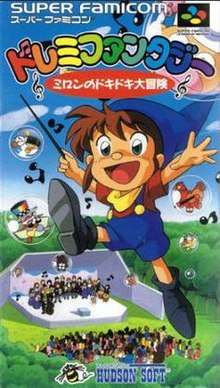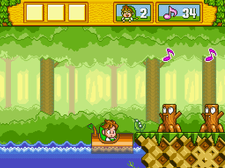DoReMi Fantasy
DoReMi Fantasy: Milon's DokiDoki Adventure[lower-alpha 1] is a 1996 Japanese platform game developed and published by Hudson Soft for the Super Famicom.[1] It later re-released for the Virtual Console in 2008.[1]
| DoReMi Fantasy: Milon's DokiDoki Adventure | |
|---|---|
 | |
| Developer(s) | Hudson Soft |
| Publisher(s) | Hudson Soft |
| Director(s) | Yukiko Mikami |
| Producer(s) | Shigeki Fujiwara Takeshi Sawaguchi |
| Designer(s) | Tadayuki Kawada Koji Innami |
| Programmer(s) | Yasuhiro Kosaka Atsuo Nagata Tetsuharu Takashima |
| Artist(s) | Shoji Mizuno Naoto Yoshimi |
| Composer(s) | Jun Chikuma |
| Platform(s) | Super Famicom |
| Release |
|
| Genre(s) | Platformer |
| Mode(s) | Single-player |
Story
In the game, Milon, a young boy, heads in a mission to restore the music from the forest of his hometown and rescue his friend, the fairy Alis, from an evil wizard known as Amon, who is also responsible for the music's disappearance. To do this, he must collect a series of magic instruments that are being held by Amon's strongest minions. However, said instruments have had their power locked away after Amon corrupted them, so Milon must also collect stars to purify the instruments.
Gameplay

DoReMi Fantasy is somewhat different from the original Milon's Secret Castle. This game is more of a straight platformer, while its predecessor combined platforming with puzzles and exploration. The game also has a more lighthearted and whimsical tone than the original. The game no longer takes place at a dark castle with several rooms, but in several thematic areas spread in seven worlds, which are displayed in a world map. Each world is divided by a few levels that must be cleared one after another, with a boss at the end. Milon's basic attack still consists of bubbles, although they are now used to trap enemies in them first and knock them away before said enemies escape. There are other, more powerful attack techniques such as a charged bubble, and various power-ups are able to enhance Milon's bubble-blowing, such as ones that increase his range or the number of bubbles he can blow in one interval. Bubbles can still be used to destroy blocks to uncover items or open new paths in the levels.
Similar to the Super Mario series, Milon can jump on enemies and stun them. Milon's health level is reflected by the clothes he is wearing. If he has not been touched, his clothes are colored green. When he is hit, his clothes will changed to blue, and later, red. If he is touched while wearing red, the player loses a life. The player is able to restore health by picking up overalls power-ups; one pair of overalls restores one unit of health, while twin overalls restore two. Unlike the first game, dying once does not necessarily mean game over, as the player can collect extra lives throughout the level. Milon can collect a variety of items to aid him throughout the level. These include winged boots that allow him to slow his descent by holding the B button in midair, bubblegum that will save him from a fall down a bottomless pit (but is consumed after it is used), and keys that are required to clear maze stages.
Development
The game is a sequel to Milon's Secret Castle (1988).[2][3] Art director for the game was Shoji Mizuno.[4]
Release
It was released in Japan on March 22, 1996.[5][1] The game has become a rare sought after collector's item.[6] It was later re-released for the Wii's Virtual Console in North America in March 2008 and in Europe in September 2008.[7][1][8] The re-release was untranslated with Japanese text.[9][10][11]
Reception
In 2008, IGN gave it a score of 7.5 out of 10.[12] Nintendo life gave it a 9 out of 10.[13] Eurogamer gave it an 8 out of 10.[14]
Notes
- DoReMi Fantasy: Milon's DokiDoki Adventure (ドレミファンタジー ミロンのドキドキ大冒険, DoReMi Fantasy: Milon no DokiDoki Daibouken)[1]
References
- "ドレミファンタジー 〜ミロンのドキドキ大冒険〜 [スーパーファミコン]". Famitsu. Enterbrain Inc. Archived from the original on 2018-07-24. Retrieved 2018-07-24.
- "DoReMi Fantasy | Retro Gamer". Archived from the original on 2018-07-31. Retrieved 2018-07-31.
- "A guide to gaming's most valuable treasures". Eurogamer.net. Archived from the original on 2017-11-12. Retrieved 2018-07-31.
- "Shoji Mizuno, Bomberman Character Designer, Has Passed Away - Siliconera". Siliconera. 2018-06-12. Archived from the original on 2018-06-22. Retrieved 2018-07-31.
- "It Came From Japan! DoReMi Fantasy". destructoid. Archived from the original on 2016-04-06. Retrieved 2018-07-24.
- Massey, Tom (January 25, 2015). "A guide to gaming's most valuable treasures". Eurogamer. Retrieved August 10, 2018.
- "DoReMi Fantasy and Puyo Puyo 2 Now Available on Wii Shop Channel!". Nintendo of America. 10 March 2008. Archived from the original on 5 November 2008. Retrieved 9 September 2009.
- "Virtual Console Monday (3-25-10) Turning Japanese edition". Ars Technica. Archived from the original on 2012-12-02. Retrieved 2018-07-31.
- Thomas, Lucas M. (2008-03-17). "Puyo Puyo 2: Tsuu Review". IGN. Archived from the original on 2017-07-29. Retrieved 2018-07-31.
- "Wii Virtual Console Survival Guide". IGN. 2011-07-26. Archived from the original on 2015-05-30. Retrieved 2018-07-31.
- Staff, I. G. N. (2008-09-05). "Nintendo's Hanabi Festival Enters Its Second Week with Two More Spectacular Titles". IGN. Archived from the original on 2014-04-06. Retrieved 2018-07-31.
- Thomas, Lucas M. (2008-03-10). "DoReMi Fantasy: Milon's DokiDoki Adventure Review". IGN. Archived from the original on 2017-07-28. Retrieved 2018-07-31.
- Life, Nintendo (2008-03-11). "Review: DoReMi Fantasy: Milon's DokiDoki Adventure (Wii Virtual Console / Super Nintendo)". Nintendo Life. Archived from the original on 2017-09-27. Retrieved 2018-07-31.
- "Virtual Console Roundup". Eurogamer.net. Archived from the original on 2015-11-05. Retrieved 2018-07-31.
External links
- Official website (archived) (in Japanese)
- Nintendo Virtual Console site (in Japanese)